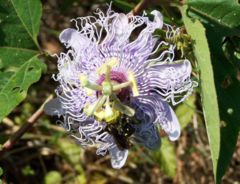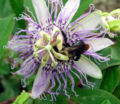Passiflora incarnata
| Standard Cyclopedia of Horticulture |
|---|
|
Passiflora incarnata, Linn. WiLD Passion-flower. May- Pop. Fig. 2768. Tall-climbing strong perennial vine, glabrous or nearly so. becoming 20-30 ft. long: lvs. 3-lobed to about half their depth, broadly cordate- ovate in outline, serrate, the petiole bearing 2 glands near the top: fl. axillary and solitary, about 2 in. across, white, with a light purple corona band at its center: fr. oblong, about 2 in. long, with 3 sutures, yellow when ripe, edible. Dry places, Va., south and west. B.M. 3697. Mn. 9:17.—A weedy plant, but offered by dealers in native plants. With protection, the roots will survive the winter as far north as Baltimore, and the strong herbaceous vines make a fine cover for arbors and verandas. Easily grown from seeds.
|
_
_NOTOC__
Passiflora incarnata {{{latin_name}}}
|
Wild passion vine, Maypop, Purple passionflower, Wild apricot, May apple
| ||||||||||||||||||||||||||||||||||||||||
|---|---|---|---|---|---|---|---|---|---|---|---|---|---|---|---|---|---|---|---|---|---|---|---|---|---|---|---|---|---|---|---|---|---|---|---|---|---|---|---|---|---|

|
|
| |||||||||||||||||||||||||||||||||||||||
| |||||||||||||||||||||||||||||||||||||||||
- Do you have a description of this genus or plant? Edit this section!
The yellow mucilage around the seeds of the egg-sized fruit is sweet and edible, however it is quite seedy and mostly benefits wildlife.
- More information about this species can be found on the genus page.
Cultivation
| calendar? | ||
|---|---|---|
| January: | ||
| February: | ||
| March: | ||
| April: | ||
| May: | ||
| June: | ||
| July: | ||
| August: | ||
| September: | ||
| October: | ||
| November: | ||
| December: | ||
| Notes: | ||
- Do you have cultivation info on this plant? Edit this section!
Propagation
- Do you have propagation info on this plant? Edit this section!
Easily from seed.
Pests and diseases
- Do you have pest and disease info on this plant? Edit this section!
Cultivars
Gallery
If you have a photo of this plant, please upload it! Plus, there may be other photos available for you to add.
-
Maypop pollination
-
Passiflora incarnata, fruit at mid-summer
-
upload photo
References
External links
- w:Passiflora incarnata. Some of the material on this page may be from Wikipedia, under the Creative Commons license.
- Passiflora incarnata QR Code (Size 50, 100, 200, 500)


